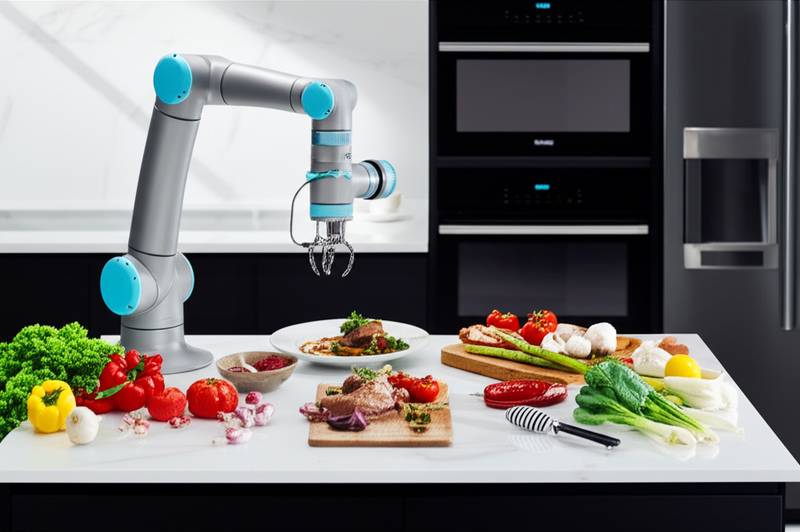Imagine a Kitchen That Prepares Meals on Command
You return home after a demanding day and instruct your smart display on the evening meal. Sleek robotic arms activate, stirring pots, flipping vegetables, and applying seasonings with exact motions. The scent of cooking spreads as you unwind. This scenario, once confined to science fiction, now represents the reality of robotic cooking systems reshaping home kitchens.
Meal preparation often consumes valuable time through chopping, stirring, and cleanup. These tasks detract from other priorities. Robotic systems address this by automating full meals hands-free while upholding restaurant standards.
Evolution of Robotic Cooking Technology
Robotic arms elevate the concept of a smart kitchen beyond basic appliances. These devices integrate robotics, sensors, and cloud recipe libraries to handle complete cooking sequences. Beyond mere ease, they deliver uniform results, enhance safety, and minimize food waste. Professionals, parents, or tech enthusiasts find these systems offer substantial improvements to daily routines.
Central to the technology are arms engineered to duplicate human hand skills. They manage stirring, flipping, ladling, and plating. When combined with induction cooktops and camera-based sensors, the setup executes recipes by controlling heat, duration, and actions accurately. Many models access extensive recipe collections and refine techniques over time, such as adjusting spices or cooking durations based on prior uses.
Components of an Automated Cooking Setup
A comprehensive robotic kitchen incorporates several key elements:
- Paired robotic arms that execute movements with precision down to millimeters.
- Intelligent cooktops and ovens equipped with sensors for temperature and activity monitoring.
- Camera systems powered by AI to recognize ingredients and verify correct positioning.
- Recipe databases providing automated, sequential directives.
- Control interfaces via voice or mobile app for initiating, pausing, or modifying preparations.
Upon starting a recipe, the arms retrieve prepared ingredients, portion them accurately, and proceed through scripted steps. Sensors monitor each phase to avoid burning or overcooking. Users monitor progress in real time via a linked application.
For optimal performance, pair the system with manufacturer-recommended cookware. These items feature designs compatible with arm grips and sensor responses. Standard household items may disrupt alignment, particularly in tasks requiring finesse, such as crepe flipping or sauce stirring.
Selecting an Appropriate Robotic System
Prospective buyers encounter options suited to varying budgets and needs.
-
Entry-Level: CookingPal Multo (approximately $1,100)
This compact unit handles chopping, blending, and cooking through a tablet-guided process. Although it omits dedicated arms, it streamlines preparation and cooking for novices or limited spaces. -
Intermediate: Thermomix TM6 (approximately $1,500)
The TM6 merges heating, mixing, and measurement functions with a vast recipe repository. It serves as a partial automation tool and connects to platforms like Alexa or Google Home. -
High-End: Moley Robotic Kitchen (starting at about $150,000)
This installation features dual arms, an integrated cooktop, and chef-curated recipes. It manages diverse dishes, from broths to intricate reductions, with exact timing. Self-cleaning capabilities complete the package.
Verify ecosystem compatibility prior to purchase. Certain models align with Apple HomeKit, while others favor Google or Amazon integrations.
Setup and Kitchen Adaptation
Deploying a full robotic system demands more than basic assembly. Requirements may include:
- Modifications to structure for mounting arms on ceilings or walls.
- Electrical enhancements to accommodate power demands of cook surfaces and motors.
- Reliable internet for recipe access and software maintenance.
For existing kitchens, engage a certified electrician and designer experienced in intelligent appliances. Countertop models typically require only plugging in, with attention to airflow and arm clearance.
Installation expenses for advanced systems range from $5,000 to $15,000, influenced by cabinet adjustments and wiring. Modular or portable variants involve minimal professional intervention.
Upkeep and Durability
Robotic systems require routine attention similar to other connected devices. Wipe sensors weekly, apply software updates promptly, and conduct diagnostics as indicated. Modular components simplify part replacements over time.
Experts note that arms depend on food-grade lubricants for fluid operation. Heat from cooking accelerates lubricant breakdown. Annual replenishment or replacement ensures reliable, silent performance.
Balancing Automation with Personal Creativity
Critics express concern that machines diminish cooking's artistic element. In practice, these kitchens amplify options without supplanting human input. Users input custom recipes via apps, enabling the system to reproduce family favorites with unwavering accuracy. Consider preserving a cherished family stew recipe for consistent recreation across years.
The primary benefits involve reliability and liberation. Individuals direct the culinary direction, with robots managing technical execution. This approach preserves taste while alleviating effort and tension.
Investment, Efficiency, and Forward Compatibility
Current pricing remains elevated, though market expansion will lower costs. Hybrid models blending automation and hands-on elements provide current balance. Prioritize systems supporting expansions, like additional arms or updated recipe sets.
Consider energy consumption as well. Induction-based cooking in these units proves 15 to 20 percent more efficient than gas or conventional electric methods. Such savings gradually recoup initial outlays.
Steps to Integrate Robotic Cooking
To adopt this technology, begin with accessible tools. Experiment with semi-automated devices before committing to comprehensive installations. Seek certified specialists through home tech platforms for guidance on seamless incorporation.
Automated cooking transitions from novelty to necessity, fostering environments of ease and innovation. The subtle operation of an arm preparing your meal could become routine, akin to brewing morning coffee.
Prepare to evolve your kitchen into a harmonious blend of advanced tools and culinary delight.
Frequently Asked Questions
How do robotic cooking arms ensure safety?
These systems employ temperature monitors, movement restrictions, and auto-shutoff mechanisms to avert mishaps.
What space requirements apply to robotic kitchens?
Countertop units need about 2 square feet, while full installations demand 10 to 15 square feet plus mounting clearance.
Can robotic systems accommodate dietary restrictions?
Yes, recipe libraries include filters for allergies, vegan options, and low-sodium preferences, with app-based customizations.
How long does a typical cooking session last?
Most meals complete in 20 to 45 minutes, depending on complexity, comparable to manual preparation times.
